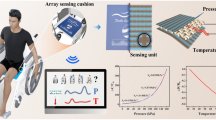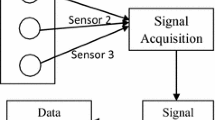Summary
A thermo-esthesiometer was devised for the investigation of sensory disorders among operators of vibration tools. Moreover, its usefulness for diagnosis was investigated. The esthesiometer was composed of a copper pipe 80 cm long that was heated at one end with an electric heater and chilled at the other end with a cooling mixture of NaCl and ice. The temperature at each point of the copper pipe was measured using a sliding surface-thermometer. It gave a sigmoidal temperature gradient between 8.5° and 47.5°C at a room temperature of 20°C. It took about 30 min to complete a stable temperature gradient from the start of heating and cooling. The profile of the temperature gradient curve was a function of room temperature. The stability of the temperature gradient curve was to be maintained satisfactorily for more than 5 h at a constant room temperature below 28°C. The size of this apparatus, when it was broken up, was small enough to carry around easily. Using this esthesiometer, the warm and cool thresholds were measured at the fingertips of operators of vibration tools. From the results obtained the hypesthesia of temperature sense was shown to correlate very strictly with the stage of vibration disease. In particular, an upward deviation of warm threshold and an increase of the width of the neutral zone were observed in those patients.
Similar content being viewed by others
References
Drogichina EA (1971) The clinical observations of vibration disease. In: Letavet AA, Drogichina EA (eds) Vibration in industry. Meditzina, Moskow (Rus)
Hettinger TH, Beck W (1956) Die Reaktionsfähigkeit der peripheren Gefäße als dispositioneller Faktor für die Entstehung von Gelenkerkrankungen. Int Z Angew Physiol Arbeitsphysiol 16:250–264
Hosokawa M (1975) The diagnostic standards of vibration disease. Jap J Ind Health 17:48–49 (Jpn)
Iwata H, Dupuis H, Freund JL, Hartung E (1973) Bei Hand-Arm-Schwingungen auftretende Erkrankungen. Arbeitsmed Sozialmed Präventivmed 8:295–296
Kenshalo DR, Decker T, Hamilton A (1967) Special summation on the forehand, forearm, and back produced by radiant and conducted heat. J Comp Physiol 63:510–515
Klimiková-Deutschová E (1966) Neurologische Aspekte der Vibrationskrankheit. Int Arch Gewerbepath Gewerbehyg 22:297–305
Author information
Authors and Affiliations
Rights and permissions
About this article
Cite this article
Hirosawa, I. Original construction of thermo-esthesiometer and its application to vibration disease. Int. Arch Occup Environ Heath 52, 209–214 (1983). https://doi.org/10.1007/BF00526519
Received:
Accepted:
Issue Date:
DOI: https://doi.org/10.1007/BF00526519




